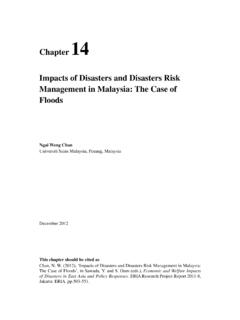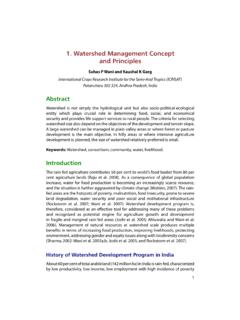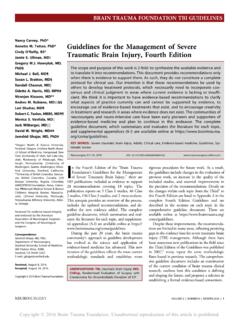Transcription of Rural Sustainable Drainage Systems (RSuDS)
1 Title here in 8pt Arial (change text colour to black) i Rural Sustainable Drainage Systems (RSuDS) ii Rural Sustainable Drainage Systems (RSuDS) The Environment Agency is the leading public body protecting and improving the environment in England and Wales. It s our job to make sure that air, land and water are looked after by everyone in today s society, so that tomorrow s generations inherit a cleaner, healthier world. Our work includes tackling flooding and pollution incidents, reducing industry s impacts on the environment, cleaning up rivers, coastal waters and contaminated land, and improving wildlife habitats. This report is the result of research commissioned and funded by the Environment Agency. Published by: Environment Agency, Horizon House, Deanery Road, Bristol, BS1 5AH ISBN: 978-1-84911-277-2 Environment Agency June 2012 All rights reserved. This document may be reproduced with prior permission of the Environment Agency.
2 The views and statements expressed in this report are those of the author alone. The views or statements expressed in this publication do not necessarily represent the views of the Environment Agency and the Environment Agency cannot accept any responsibility for such views or statements. Further copies of this report are available from our publications catalogue: or our National Customer Contact Centre: T: 08708 506506 E: Author(s): Dr Lisa M Avery Catchment management , Macaulay Institute Dissemination Status: Publicly available Keywords: Sustainable Drainage , Rural SuDS, cost-effectiveness of measures, diffuse pollution Environment Agency s Project Manager: Jamie Letts, Environment and Business Collaborator(s): Allerton Research and Educational Trust Lancaster University Macaulay Land Use Research Institute Newcastle University Rural Sustainable Drainage Systems (RSuDS) iii Evidence at the Environment Agency Evidence underpins the work of the Environment Agency.
3 It provides an up-to-date understanding of the world about us, helps us to develop tools and techniques to monitor and manage our environment as efficiently and effectively as possible. It also helps us to understand how the environment is changing and to identify what the future pressures may be. The work of the Environment Agency s Evidence Directorate is a key ingredient in the partnership between research, guidance and operations that enables the Environment Agency to protect and restore our environment by: Setting the agenda, by providing the evidence for decisions; Maintaining scientific credibility, by ensuring that our programmes and projects are fit for purpose and executed according to international standards; Carrying out research, either by contracting it out to research organisations and consultancies or by doing it ourselves; Delivering information, advice, tools and techniques, by making appropriate products available.
4 Miranda Kavanagh Director of Evidence iv Rural Sustainable Drainage Systems (RSuDS) Executive summary Rural Sustainable Drainage Systems (SuDS) are not a new concept, but they are not widespread in the Rural environment and could present many opportunities for improving our management of water at source. They are a collection of physical structures used to mimic natural processes. In Rural environments, it is an approach for managing the detrimental impact of rainfall on fields where run-off is a major threat to the flora, fauna and chemical status of our surface waters. Rural SuDS are tools that help maintain and manage the provision of good water quality. They provide an important role by intercepting run-off and trapping soil before it leaves the field. Traditional Drainage to manage surface water run-off is designed to carry water away quickly, without treatment, and can rapidly transfer pollutants and large volumes of water to streams, rivers, lakes and estuaries.
5 Rural SuDS slow down or prevent the transport of pollutants to watercourses by breaking the delivery pathway between the pollutant source and the receptor. By intercepting run-off and trapping sediment before it leaves the field they help maintain and manage the provision of good water quality by preventing the loss of soil, chemicals, nutrients and faecal organisms. A further benefit is their ability to temporarily capture water and slow down flow. This can reduce localised flooding and provide valuable aquatic habitats in the form of micro-wetlands for farmland wildlife and will encourage the downward movement of water to recharge aquifers. The report provides a list of existing land management options that fit the definition of Sustainable Drainage and reviews their cost and effectiveness in helping to meet the objectives of the Water Framework Directive, to reduce flood risk and adapt to climate change.
6 Options explored in the report include trenches, wetlands, retention ponds and buffers and many of these features can be further enhanced by sediment traps as part of the design. Whilst Rural SuDS may be more complex to create compared to a simple buffer strip, this is off-set by a number of additional benefits for the landowner. They can make existing features such as buffer strips, walls and new hedgerows even more effective; they are not demanding on space and by trapping sediment in the field will save a valuable resource. Rural SuDS are one group of measures that can be created with minimum loss of agricultural production. They should be used as part of a systemic approach to managing run-off, lowering flood risk and increasing water adsorption. They are good examples of being able to deliver multiple benefits but need to be planned and targeted as part of future catchment management .
7 The measures identified in this report may offer some of the answers towards tackling diffuse pollution to improve the chemical and ecological status of surface water in the short to medium term; whilst in the longer term, they will enable land managers to adapt to intensive rainfall that is more likely with our changing climate. Rural Sustainable Drainage Systems (RSuDS) v Acknowledgements Acknowledgement and thanks to all those who are helping to put science into practice and have developed practical solutions for a very difficult question. Newcastle University Lancaster University Allerton Research and Education Trust Macaulay Land Use Research Institute EA Evidence Directorate vi Rural Sustainable Drainage Systems (RSuDS) Contents 1 Introduction 1 Aim of this report 1 2 Rural Sustainable Drainage Systems 2 Definition of Rural Sustainable Drainage System 2 General Description of Rural Sustainable Drainage System 2 What RSuDS does not include 2 3 Why control runoff?
8 3 Diffuse pollution 3 Diffuse pollution delivery in the landscape 6 Protection of water resources 6 Flooding 7 Climate change 7 Biodiversity 10 Amenity 10 4 Existing Rural Drainage Systems 11 5 Geographical Application of RSuDS 13 6 RSuDS Options 15 Assessment category definitions 15 RSuDS components 17 Sediment traps 17 In ditch options 19 Ponds 31 Use of woodland 39 Buffer strip/headland options 41 Wetlands 52 Farm buildings 55 Other 63 Qualitative summary and comparison 73 Knowledge gaps 74 7 Potential delivery mechanisms 75 8 Summary and conclusions 77 9 Technical Annex 78 10 References 121 Rural Sustainable Drainage Systems (RSuDS) 1 1 Introduction Man s activities on land, in both the built and Rural environment can alter the characteristics of natural soils that can lead to losses of topsoil and increase the flow of water to rivers and lakes.
9 The loss of soil and vegetation can remove an important filtering mechanism for surface water run-off. Traditional Drainage to manage surface water run-off is designed to carry water away quickly, without treatment and can rapidly transfer pollutants and large volumes of water to streams, rivers, lakes and estuaries. While there is no specific legislation to ensure that issues of sustainability are considered with regard to Drainage , Sustainable Drainage Systems (SuDS) have been encouraged in the urban environment through local Agenda 21 initiatives and through planning policy PPS25 (England) and TAN 15(Wales) which directly identify their potential to reduce flooding(1). SuDS mimic the natural Drainage characterising the site prior to development. For example, erecting buildings and creating impervious roadways or car parks is likely to remove an area of land which previously allowed infiltration of rainwater and surface run-off.
10 Rather than directing the run-off as rapidly as possible to a receiving water body, Sustainable Drainage Systems seek to minimise the impacts of development on the quality and quantity of run-off, while maximising amenity and biodiversity opportunities(2). Agricultural best practice guidance documents (Defra Good agricultural practice guidance(3), EA Best Farming Practices booklet(4), SEPA BMPs(5), Defra Inventory of DWPA measures(6)) make reference to measures which fall within the definition of SuDS and are applicable in the Rural environment. Bringing a suite of SuDS approaches similar to those which are becoming routinely used in the urban areas into Rural (frequently but not exclusively agricultural) landscapes could reduce peak storm flow(7,8) to receiving waters and associated diffuse pollution, thus helping to prepare for extreme events associated with climate change.

















